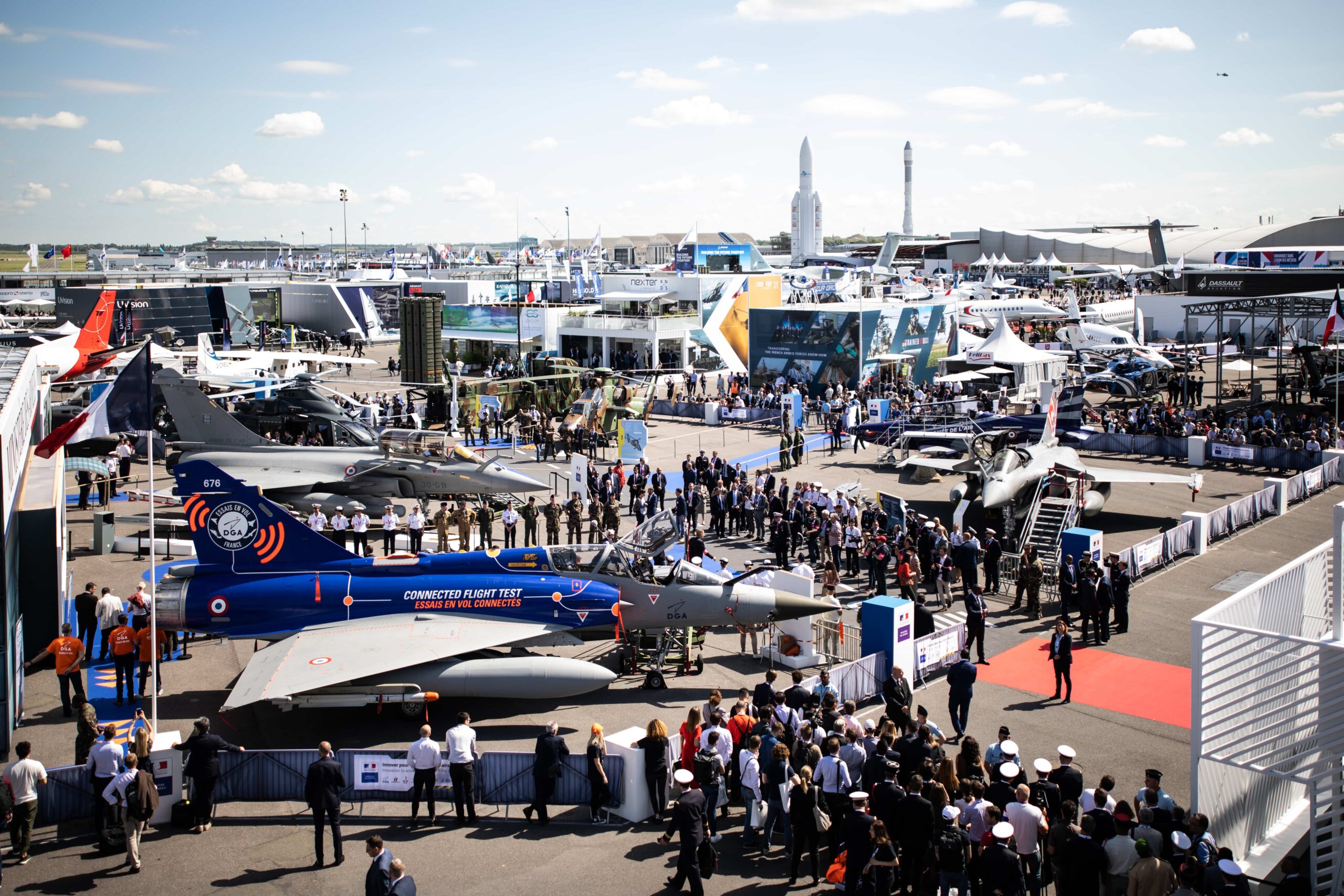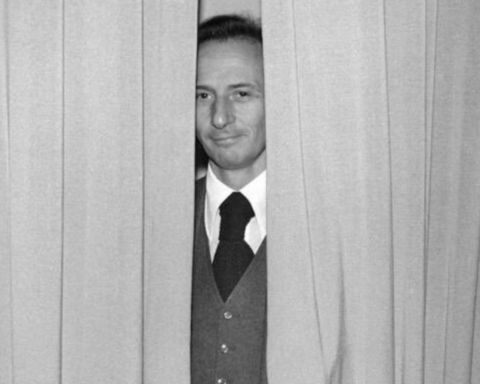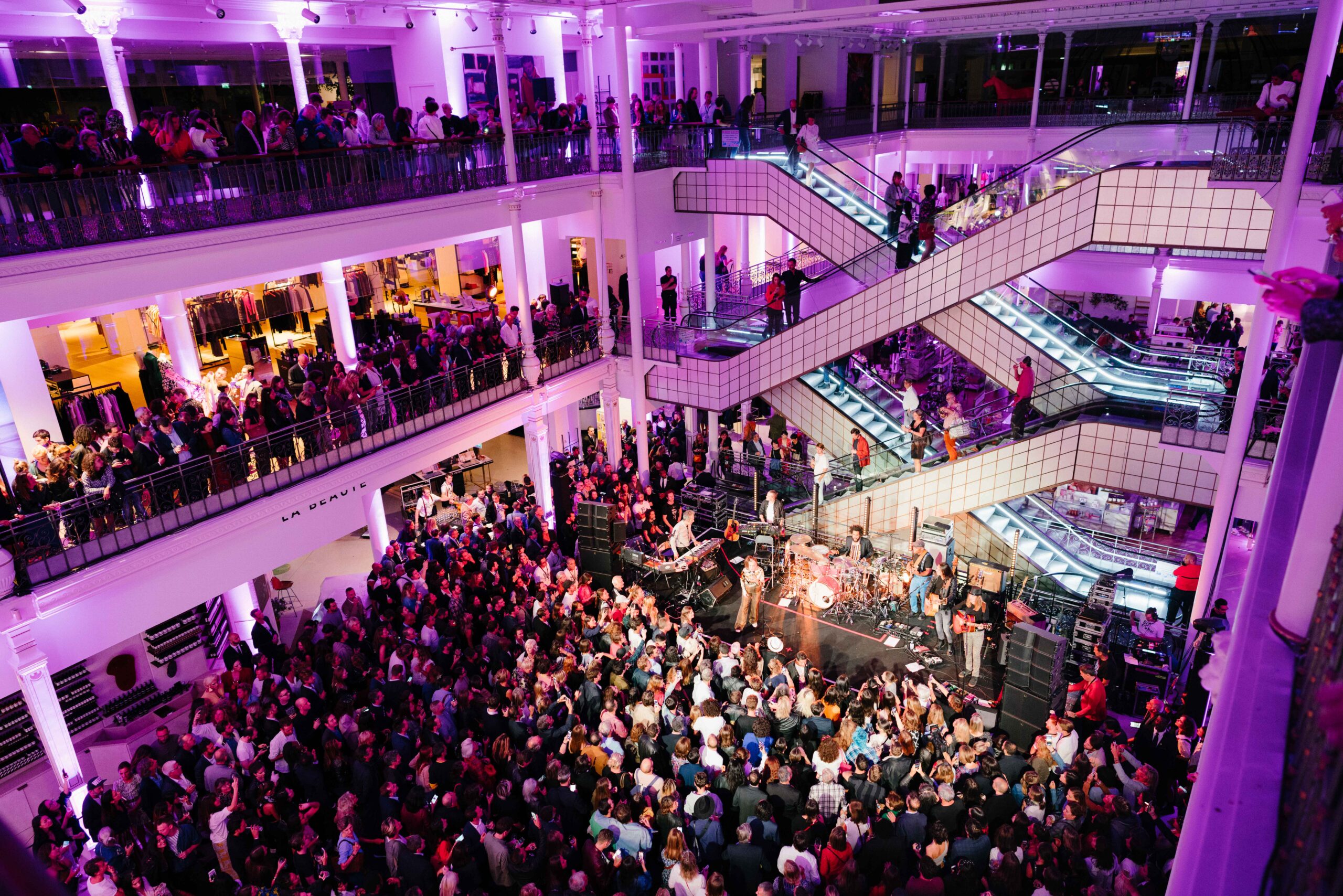[vc_row njt-role=”people-in-the-roles” njt-role-user-roles=”administrator,editor,author,armember”][vc_column][vc_column_text]
The Paris Air Show kicked off for a week on Monday June 19, following the cancellation of the 2021 edition. With over 320,000 visitors expected, more than 2,500 exhibitors from all over the world will be showcasing the latest technological advances in the sector – a record edition. And yet, at a time when aircraft orders are multiplying, the event is being held under the banner of decarbonization.
The 54th Le Bourget International Air & Space Show, the world’s biggest aerospace event, opened its doors on Monday June 19th and will run until Sunday June 25th.
Organized by the Groupement des Industries Françaises Aéronautiques et Spatiales (GIFAS), this meeting place for all those involved in the aviation and aerospace industries traditionally takes place every two years. However, due to the pandemic, the 2021 edition was cancelled, making the 2023 event the first in four years. The event is expected to generate a flurry of orders, and consulting firm AlixPartners even goes so far as to predict the return of the giant contracts, known as “megadeals“, characteristic of previous shows.
In France, the aeronautics sector employs 200,000 people, and is looking to recruit a further 25,000 for skilled jobs. It generates sales in excess of 60 billion euros, and exports 80% of its production. Along with luxury goods and agri-food, aeronautics is one of our very few industrial strengths.
Major orders
The Paris Air Show is primarily a commercial event, with four days reserved for professionals. And once again this year, it will be the scene of a close confrontation between the world’s number one aircraft manufacturer, Airbus, and its American rival, Boeing. The European company is struggling to ramp up production due to delays at its suppliers, while the American is facing new production problems for both its 737 and its 787 long-haul aircraft. At the last show in 2019, a total of 140 billion contracts were signed, bringing together aircraft manufacturers and industrialists.

By the end of the first half of the year, the number of aircraft ordered, already confirmed or still to come, is expected to exceed 2,000 units, more than half of which are expected exclusively at the Paris Air Show. This figure is so impressive that some experts are beginning to fear the formation of a bubble.
At Le Bourget, Turkish Airlines could announce the largest order in the history of civil aviation, amounting to 600 aircraft: 400 medium-haul Airbus A320s or Boeing 737 MAXs, and 200 long-haul Airbus A350s, Boeing 787s or 777s. India’s Indigo is also expected to drive the market, with a planned purchase of 500 A320 Family medium-haul aircraft and 25 Airbus A350 long-haul aircraft. This huge order follows that announced a few months ago by Air India (a total of 470 aircraft, split almost equally between the two aircraft manufacturers). Faced with the influx of orders, Airbus and Boeing need to increase production rates without disrupting the supply chain, in order to serve their customer airlines as quickly as possible.
Decarbonization objective
Some manufacturers and suppliers in the industry are seeking to reduce greenhouse gas emissions from the aviation sector. They are considering, for example, doing away with traditional kerosene. However, even if the sector has regained a certain vigor, nothing will be the same again.
Over the past four years, criticism of aviation has intensified, and air transport is often an easy target in the fight against carbon emissions. Yet it accounts for just 2.4% of global CO2 emissions, half as much as the digital sector which, with the servers hosting TikTok videos, Netflix and Instagram stories, is responsible for 5% of emissions. Jean-Marc Jancovici, the creator of the carbon footprint, even proposes a quota of four flights per person over the course of a lifetime…
The hydrogen debate
Nearly 2,500 exhibitors were on hand to promote their latest technologies aimed at reducing the sector’s emissions. Surprisingly, however, hydrogen was relegated to the background in this central area of the show. For some time, this mode of propulsion was presented as the solution, but the discourse has clearly evolved.
“Today, we’re cautious about saying that we need to build new hydrogen-powered aircraft before we can estimate that we’ll be able to refuel with hydrogen and take off”, explains Baptiste Voillequin, Director of Research and Development at GIFAS. In reality, the adoption of hydrogen would require an overhaul of aircraft design. Until now, fuel was mainly stored in the aircraft’s wings. However, given the greater need for hydrogen storage, this space would be insufficient.
“We’re going to need tanks that are three times as big, and especially tanks that are going to be much harder to integrate, because we’re not going to be able to put small tanks just anywhere. So, obviously, we can’t imagine just taking an aircraft and integrating these tanks”, explains Nicolas Jeuland, fuel expert at Safran. As a result of the difficulties encountered last autumn, the Airbus CEO expressed initial reservations about the 2035 deadline.
Read also >Boeing beats Airbus in first quarter
Featured photo : © SIAE[/vc_column_text][/vc_column][/vc_row][vc_row njt-role=”not-logged-in”][vc_column][vc_column_text]
The Paris Air Show kicked off for a week on Monday June 19, following the cancellation of the 2021 edition. With over 320,000 visitors expected, more than 2,500 exhibitors from all over the world will be showcasing the latest technological advances in the sector – a record edition. And yet, at a time when aircraft orders are multiplying, the event is being held under the banner of decarbonization.
The 54th Le Bourget International Air & Space Show, the world’s biggest aerospace event, opened its doors on Monday June 19th and will run until Sunday June 25th.
Organized by the Groupement des Industries Françaises Aéronautiques et Spatiales (GIFAS), this meeting place for all those involved in the aviation and aerospace industries traditionally takes place every two years. However, due to the pandemic, the 2021 edition was cancelled, making the 2023 event the first in four years. The event is expected to generate a flurry of orders, and consulting firm AlixPartners even goes so far as to predict the return of the giant contracts, known as “megadeals“, characteristic of previous shows.
In France, the aeronautics sector employs 200,000 people, and is looking to recruit a further 25,000 for skilled jobs. It generates sales in excess of 60 billion euros, and exports 80% of its production. Along with luxury goods and agri-food, aeronautics is one of our very few industrial strengths.
Major orders
The Paris Air Show is primarily a commercial event, with four days reserved for professionals. And once again this year, it will be the scene of a close confrontation between the world’s number one aircraft manufacturer, Airbus, and its American rival, Boeing. The European company is struggling to ramp up production due to delays at its suppliers, while the American is facing new production problems for both its 737 and its 787 long-haul aircraft. At the last show in 2019, a total of 140 billion contracts were signed, bringing together aircraft manufacturers and industrialists.

By the end of the first half of the year, the number of aircraft ordered, already confirmed or still to come, is expected to exceed 2,000 units, more than half of which are expected exclusively at the Paris Air Show. This figure is so impressive that some experts are beginning to fear the formation of a bubble.
At Le Bourget, Turkish Airlines could announce the largest order in the history of civil aviation, amounting to 600 aircraft: 400 medium-haul Airbus A320s or Boeing 737 MAXs, and 200 long-haul Airbus A350s, Boeing 787s or 777s. India’s Indigo is also expected to drive the market, with a planned purchase of 500 A320 Family medium-haul aircraft and 25 Airbus A350 long-haul aircraft. This huge order follows that announced a few months ago by Air India (a total of 470 aircraft, split almost equally between the two aircraft manufacturers). Faced with the influx of orders, Airbus and Boeing need to increase production rates without disrupting the supply chain, in order to serve their customer airlines as quickly as possible.
Decarbonization objective
[…][/vc_column_text][vc_cta h2=”This article is reserved for subscribers.” h2_font_container=”tag:h2|font_size:16|text_align:left” h2_use_theme_fonts=”yes” h4=”Subscribe now !” h4_font_container=”tag:h2|font_size:32|text_align:left|line_height:bas” h4_use_theme_fonts=”yes” txt_align=”center” color=”black” add_button=”right” btn_title=”I SUBSCRIBE !” btn_color=”danger” btn_size=”lg” btn_align=”center” use_custom_fonts_h2=”true” use_custom_fonts_h4=”true” btn_button_block=”true” btn_custom_onclick=”true” btn_link=”url:https%3A%2F%2Fluxus-plus.com%2Fen%2Fsubscriptions-and-newsletter-special-offer-valid-until-september-30-2020-2-2%2F”]Get unlimited access to all articles and live a new reading experience, preview contents, exclusive newsletters…
Already have an account ? Please log in.
[/vc_cta][vc_column_text]Featured photo : © SIAE[/vc_column_text][/vc_column][/vc_row][vc_row njt-role=”people-in-the-roles” njt-role-user-roles=”subscriber,customer”][vc_column][vc_column_text]
The Paris Air Show kicked off for a week on Monday June 19, following the cancellation of the 2021 edition. With over 320,000 visitors expected, more than 2,500 exhibitors from all over the world will be showcasing the latest technological advances in the sector – a record edition. And yet, at a time when aircraft orders are multiplying, the event is being held under the banner of decarbonization.
The 54th Le Bourget International Air & Space Show, the world’s biggest aerospace event, opened its doors on Monday June 19th and will run until Sunday June 25th.
Organized by the Groupement des Industries Françaises Aéronautiques et Spatiales (GIFAS), this meeting place for all those involved in the aviation and aerospace industries traditionally takes place every two years. However, due to the pandemic, the 2021 edition was cancelled, making the 2023 event the first in four years. The event is expected to generate a flurry of orders, and consulting firm AlixPartners even goes so far as to predict the return of the giant contracts, known as “megadeals“, characteristic of previous shows.
In France, the aeronautics sector employs 200,000 people, and is looking to recruit a further 25,000 for skilled jobs. It generates sales in excess of 60 billion euros, and exports 80% of its production. Along with luxury goods and agri-food, aeronautics is one of our very few industrial strengths.
Major orders
The Paris Air Show is primarily a commercial event, with four days reserved for professionals. And once again this year, it will be the scene of a close confrontation between the world’s number one aircraft manufacturer, Airbus, and its American rival, Boeing. The European company is struggling to ramp up production due to delays at its suppliers, while the American is facing new production problems for both its 737 and its 787 long-haul aircraft. At the last show in 2019, a total of 140 billion contracts were signed, bringing together aircraft manufacturers and industrialists.

By the end of the first half of the year, the number of aircraft ordered, already confirmed or still to come, is expected to exceed 2,000 units, more than half of which are expected exclusively at the Paris Air Show. This figure is so impressive that some experts are beginning to fear the formation of a bubble.
At Le Bourget, Turkish Airlines could announce the largest order in the history of civil aviation, amounting to 600 aircraft: 400 medium-haul Airbus A320s or Boeing 737 MAXs, and 200 long-haul Airbus A350s, Boeing 787s or 777s. India’s Indigo is also expected to drive the market, with a planned purchase of 500 A320 Family medium-haul aircraft and 25 Airbus A350 long-haul aircraft. This huge order follows that announced a few months ago by Air India (a total of 470 aircraft, split almost equally between the two aircraft manufacturers). Faced with the influx of orders, Airbus and Boeing need to increase production rates without disrupting the supply chain, in order to serve their customer airlines as quickly as possible.
Decarbonization objective
[…][/vc_column_text][vc_cta h2=”This article is reserved for subscribers.” h2_font_container=”tag:h2|font_size:16|text_align:left” h2_use_theme_fonts=”yes” h4=”Subscribe now !” h4_font_container=”tag:h2|font_size:32|text_align:left|line_height:bas” h4_use_theme_fonts=”yes” txt_align=”center” color=”black” add_button=”right” btn_title=”I SUBSCRIBE !” btn_color=”danger” btn_size=”lg” btn_align=”center” use_custom_fonts_h2=”true” use_custom_fonts_h4=”true” btn_button_block=”true” btn_custom_onclick=”true” btn_link=”url:https%3A%2F%2Fluxus-plus.com%2Fen%2Fsubscriptions-and-newsletter-special-offer-valid-until-september-30-2020-2-2%2F”]Get unlimited access to all articles and live a new reading experience, preview contents, exclusive newsletters…
Already have an account ? Please log in.
[/vc_cta][vc_column_text]Featured photo : © SIAE[/vc_column_text][/vc_column][/vc_row]










